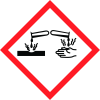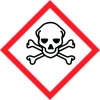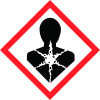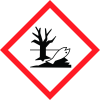1-Naphthol for synthesis
Merck KGaA
Revision date : 2021-03-13





General Information
Revision date
2021-03-13
Product name
1-Naphthol for synthesis
CAS No.
90-15-3
REACH No
is
Icons in SDS
Company Information
Company name
Merck KGaA
E-mail address of the competent person responsible for the Safety Data Sheet
TechnicalService@merckgroup.com
GHS Information
Signal word
Danger
Hazard Codes
Hazard statements (CLP)
H302, H311, H315, H317, H318, H335, H371, H400, H410, H412
Hazard statements
Code
Statements
H302
Harmful if swallowed
H311
Toxic in contact with skin
H315
Causes skin irritation
H317
May cause an allergic skin reaction
H318
Causes serious eye damage
H335
May cause respiratory irritation
H371
May cause damage to organs
H400
Very toxic to aquatic life
H410
Very toxic to aquatic life with long lasting effects
H412
Harmful to aquatic life with long lasting effects
Precautionary statements
Code
Statements
P273
Avoid release to the environment.
P280
Wear protective gloves/protective clothing/eye protection/face protection.
P301+P312
IF SWALLOWED: call a POISON CENTER/doctor/... IF you feel unwell.
P305+P351+P338
IF IN EYES: Rinse cautiously with water for several minutes. Remove contact lenses if present and easy to do - continue rinsing.
P308+P311
IF exposed or concerned: Call a POISON CENTER/doctor/...
Section 2
CLP CLASSIFICATION
Acute toxicity, Oral (Category 4), H302 Acute toxicity, Dermal (Category 3), H311 Skin irritation (Category 2), H315 Serious eye damage (Category 1), H318 Skin sensitization (Sub-category 1A), H317 Specific target organ toxicity - single exposure, Oral (Category 2), Kidney, H371 Specific target organ toxicity - single exposure (Category 3), Respiratory system, H335 Short-term (acute) aquatic hazard (Category 1), H400 Long-term (chronic) aquatic hazard (Category 3), H412 For the full text of the H-Statements mentioned in this Section, see Section 16.
2.2 Label elements
Labelling according Regulation (EC) No 1272/2008
Signal word
Danger Danger
Hazard statements
H302 Harmful if swallowed. H311 Toxic in contact with skin. H315 Causes skin irritation. H317 May cause an allergic skin reaction. H318 Causes serious eye damage. H335 May cause respiratory irritation. H371 May cause damage to organs (Kidney) if swallowed. H410 Very toxic to aquatic life with long lasting effects. Reduced Labeling (<= 125 ml) H317 May cause an allergic skin reaction. H318 Causes serious eye damage. H311 Toxic in contact with skin.
Precautionary statements
P273 Avoid release to the environment. P280 Wear protective gloves/ protective clothing/ eye protection/ face protection/ hearing protection. P301 + P312 IF SWALLOWED: Call a POISON CENTER/ doctor if you feel unwell. P302 + P352 + P312 IF ON SKIN: Wash with plenty of water.Call a POISON CENTER/ doctor if you feel unwell. P305 + P351 + P338 IF IN EYES: Rinse cautiously with water for several minutes. Remove contact lenses, if present and easy to do. Continue rinsing. P308 + P311 IF exposed or concerned: Call a POISON CENTER/ doctor. P280 Wear protective gloves/ protective clothing/ eye protection/ face protection/ hearing protection. P302 + P352 + P312 IF ON SKIN: Wash with plenty of water.Call a POISON CENTER/ doctor if you feel unwell. P305 + P351 + P338 IF IN EYES: Rinse cautiously with water for several minutes. Remove contact lenses, if present and easy to do. Continue rinsing.
Supplemental label elements
none none
2.3 Other hazards
This substance/mixture contains no components considered to be either persistent, bioaccumulative and toxic (PBT), or very persistent and very bioaccumulative (vPvB) at levels of 0.1% or higher.

